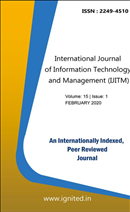Study the Factors Promoting the Rise of Strategic Alliances
Main Article Content
Authors
Abstract
For public-private area alliances the public authority impact is intense. All things being equal, for private-private area this factor is additionally a worry as these alliances work inside a climate where government public strategies and laws identifying with framework and banking and superannuation guidelines have an immediate bearing on presentation. Further impacts are additionally apparent of positive financial development with no sign that this is lessening. This, combined with the current worldwide period of prosperity, has ensnare a decidedly on the monetary exhibition of the alliances. At the hierarchical level, the ramifications are that staff has got more ability arranged and knowledgeable with strategic standpoint in their presentation. Also, the accessibility of refined innovation in the business climate has gotten effectively open. Numerous corporate cases has been come about with alliances to get to the banking and advantage store organization advancements of their accomplices. As innovation influences the interaction the executives of alliances and has direct ramifications for level for execution levels, in this way undoubtly strategic alliances has started receiving monetary rewards from mechanical proficiency gains coming about. The improvement of coalition the board abilities in North India is as yet in an undeveloped stage except for few situations where staff have the essential abilities.
Downloads
Download data is not yet available.
Article Details
Section
Articles
References
- Collett, Stacey (1999). "SWOT Analysis." Computerworld, Vol.33 Issue 29, Jul.19, 1999.
- Hay, Robert D. (1990). Strategic management in non-profit organizations, Westport: Greenwood Press, 1990.
- Ramanathon, Kavasserei V. and Hegstad, Larry P. Readings in Management Control in Nonprofit Organizations, New York: John Wiley and Sons Inc., 1982.
- Stone, Melissa, Bigelow, Barbara, & Crittenden, William. "Research on Strategic Management in Non-Profit Organizations." Administration and Society, 1999.
- "Asymmetric Equilibria in the War of Attrition," Journal of Theoretical Biology, 113 (1985), pp. 517—527.
- "Self-Selection and Testing," Review of Economic Studies, 54 (2) , April 1987, 265—279, (with David > Scharfstein).
- "Brinkmanship and Nuclear Deterrence: The Neutrality of Escalation," Conflict Management and Peace > Science 9 (2), Spring 1987, 19—30.
- Barry Bozeman and Jeffrey D. Straussman, Public Management Strategies: Guidelines for Managerial > Effectiveness. Oxford: Jossey-Bass Publishers, 1990.
- Hayes, Robert H., "Why Strategic Planning Goes Awry." The New York Times, April 20, 1986.
- Nutt, P.C., and Backoff, R.W. "A Strategic Management Process for Public and Third-Sector Organizations."
- Distinctive Contexts and./ Constraints." Academy of Management Review, 1985, 10, pp.276-86.
- Louise G. White, Managing Policy Reform in the LDCs. Boulder, Colorado: Lynne Reinner Publishers, 1990.

